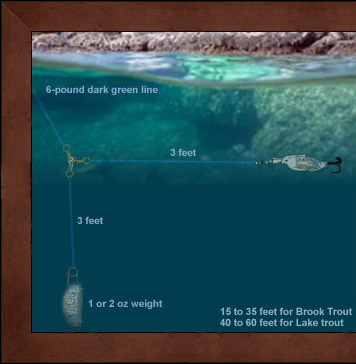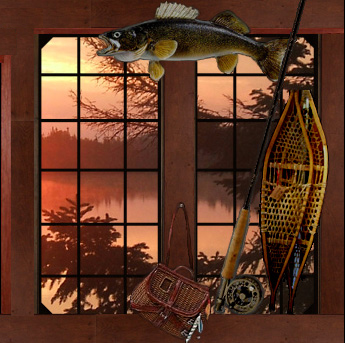|
FISHING TIPS: (Check back again for more tips)
Fishing Protected Bays Article
In early spring, the Lake Trout are just below the surface. This time of year most Lake Trout hunters will troll free-line behind the boat with a Cleo or other casting trout lures.
Lake Trout are very sensitive to the sound of the motor so trolling directly behind the boat, especially on a calm day, puts your lure where the boat just passed through and there is a good chance the motor scared the trout off to the side.
|
|
To maximize the amount of strikes, try casting as far as you can about 60 to 90 degrees off to the side of the boat and then let the boat pull your line straight. Once the line is straight behind the boat, troll for a couple of minutes and then reel in and do it all over again. It's a bit more work but in can double or triple the amount of strikes you get because there will be a lot more trout off to the side because they swim away from the sound of your motor.
Trout may follow your lure for a while before striking, which is why you need to wait a few minutes before reeling in.
|
|

|

|
Catch Lake Trout with a Walleye stick and 6 pound test line, you're crazy. I hear that a lot.
Just about any Lake Trout method works on Trout Lake because there is such a high population of trout. So just for fun, why not try to bring in a big Laker with your walleye stick and light line. If he gets off, who cares, you'll get another one soon.
Get a three-way-swivel. Tie a 3-foot line from the swivel to a small trout lure like a 1/4 oz Cleo, Williams Wabbler or a Sutton Silver Spoon. You need a small lure with lighter equipment. Tie a 3-foot line from your swivel to a 1 or 2-oz sinker. Then tie your line from your reel to the swivel. With 6-pound test line, the line has little friction with the water so if you troll really slow or back-troll, you can fish 70 feet deep with a 2 oz weight. If you are shallower like 30 to 45 feet, you may only need 1 oz.
Slowly drop your line down so the rig does not get tangled. When you hit bottom, reel up a foot and away you go. We have pulled in trout over 20 pounds on 6-pound test. Just keep your drag set for 6-pound's strength and have fun. A 20-pounder will take 20 minutes or more to bring in. It's just too much fun.
|
|
 
|

|
Throughout the summer, different insects and small amphibians hatch at different times. In Trout Lake, there are Tadpoles, Mosquito Larva, May Fly Larva, Black Fly Larva, Catus Fly Nymph and Dragon Fly Nymph, which all hatch at different times. These aquatic creatures also move differently in the water and when abundant, can change the feeding behavior of fish.
Later in the summer, before these creatures become adults, they have a transition period between breathing in water and breathing in air. Tadpoles for example tend to float up to the surface, take a breath of air and then swim down. It's a similar motion when using a floating jig.
Slide a small slip sinker on your line. Then tie the end to your floating jig. Then clip a split-shot on your line about 10 to 16 inches down from your floating jig. You can use a small twister tail, worm, pork rind or leach on your jig. Just make sure the bait is small so the floating jig floats.
Now just jig a little longer and a little slower then you would with a normal jig setup. What is happing is you are jigging the slip sinker, which is pulling the floating jig down. Then the floating jig floats back up. It's a similar motion to insect larva and tadpoles. This can be very effective later in the summer or in the afternoon when fish slow down.
|


|
Do you have a Rapala that's all chewed up or the little plastic fin broke off? You don't have to turn it into a key-chain or throw it in the garbage. It's still very useful.
Nothing gets a big monster pike PO'ed more than watching another fish trying to eat. Northern Pike are extremely competitive and like to assert their dominance in the food chain. When a pike sees a fish chasing another fish, it's time for lunch.
With this in mind, take the hooks off your broken Rapala. Then attached a black steel leader. Then attach another leader to the back of the Rapala with a spring-slip-ring. Then attach your DareDevil or what ever you want to use.
This rig is another way of triggering that animal feeding instinct. It's an old Muskie fishing trick.
|

|
If you are going to be trolling or casting with an Original Floating Rapala or other soft wood lures which have a "line eye" at the very tip, bend the "eye" down about 25 degrees. When you bend the front eye down, the lure has a lot more action and you will find fish hit it more aggressively. This may also cause the lure to go a little deeper then normal.

|

|
When you slide the twistertail onto your jig head, make sure the twistertail points up in the same direction as the hook. This will give the rubber greater wiggle action and the tail keeps twisting even if you are dragging bottom. It also helps hide the hook.
|

|

|
If you hold a northern pike or walleye up by it's eye sockets like they use to do in the old days, you squeeze their optic nerves into their brain and they die a slow death.
|

|
If you have touched a gas tank, gas line or get gasoline on your hands, scrub (wash) your hands with sugar. After you have put bug spray on, wash your hands with salt. Do this before you touch your lures to minimize transfer of undesirable scents. This will maximize fish strikes.
|

|
When casting a DareDevil into a pike bay, cast up high so your lure is falling down into the target zone. When your lure is about 3 feet above the surface of the water, sharply tug your rod towards you so the DaveDevil slaps the surface of the water. This helps trigger a feeding response from the pike.
|

|
If you have a monster pike on and he is heading towards a stump, thick lily pads or other obstacles, slap your fishing rod about a foot above the reel until he turns and swims the other way. Slapping your fishing rod sends vibrations down your fishing line to the fish and spooks him to turn around and swim the other way.
|

|











